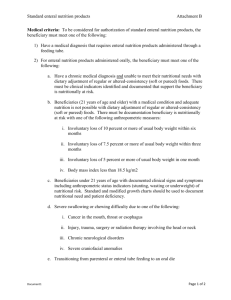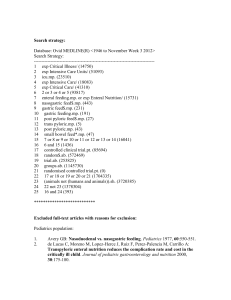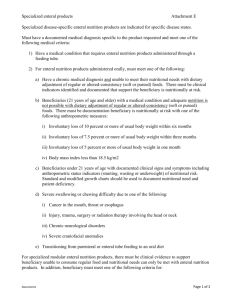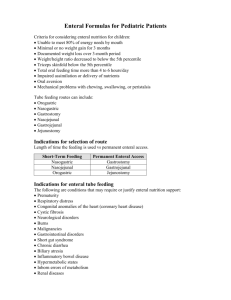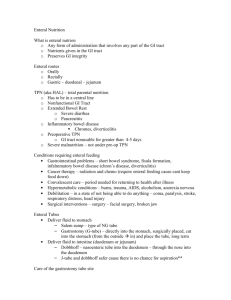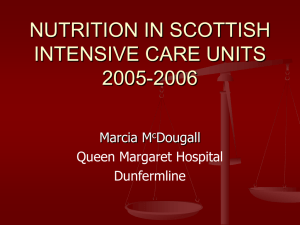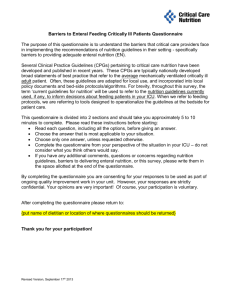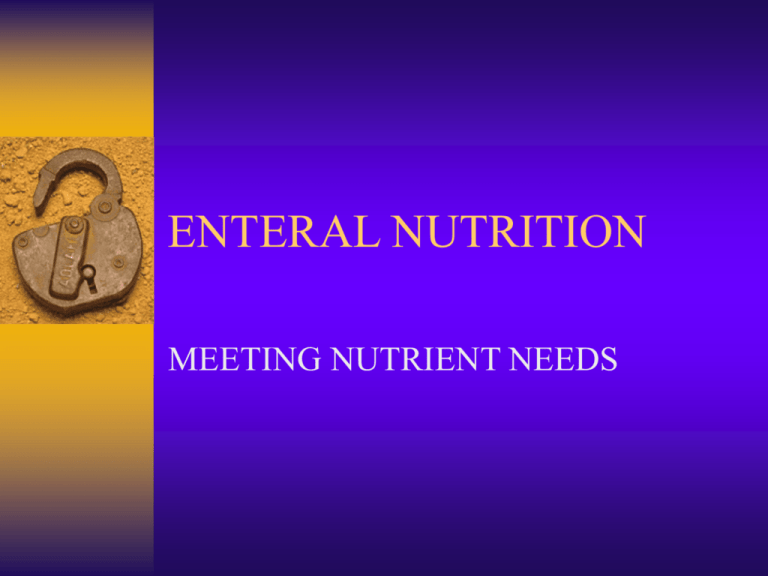
ENTERAL NUTRITION
MEETING NUTRIENT NEEDS
Selection of Feeding Route
Page 536, Krause – Figure 23-1
Algorithm or Decision Tree
– Adequate oral intake
– Oral intake + supplements
– Enteral nutrition support
•
•
•
•
Patient’s medical status
Anticipated duration of tube feeding
Risk for aspiration
Advantages and disadvantages of access route
Enteral Formula Selection
Selection Algorithm: Page 538, Krause –
Figure 23-3
Feed as close to the farm as possible: e.g.
the most intact formula the patient will
tolerate
Intact nutrient, general purpose formulas are
the least expensive and may be more
physiological
Enteral Formulary
– What products are available?
– More cost effective to have formulary
– Include multiple products, one main
brand of each category
Where can you get information
about enteral products?
Nutrition Care Manual formulary page
http://nutritioncaremanual.org/universi13
Novartis Nutrition USA
http://www.novartisnutrition.com/us/home
Abbot Nutrition Product Handbook
http://abbottnutrition.com/productHandbook/
default.asp
Nestle Nutrition
http://www.nestleclinicalnutrition.com/
Nutrition Care Manual Formulary
You can
View compositional information about adult
and pediatric formulas
Calculate nutrient delivery based on volume
Compare two formulas in the same category
BUT: be aware that the most reliable and up
to date source of information about a
formula is from the mfr.
Enteral Selection
Blenderized
– Compleat or homemade (CAUTION!)
Standard Isotonic
– Osmolite, Nutren, Isosource
Added fiber
– Jevity, Impact with Fiber, Nutren with Fiber,
– Nutren Replete with Fiber, Nutren 1.5 Fiber,
Fibersource, Fibersource HN,
Enteral Selection
Extra calories/volume restricted
– Osmolite 1.2, TwoCal HN, Novasource 2.0,
Nutren 1.5, Nutren 2.0, Peptamen 1.5, Jevity
1.2, Jevity 1.5
High nitrogen
– Osmolite HN, TwoCal HN, Fibersource HN,
Peptamen VHP, Isosource HN
Enteral Selection
Disease specific
– Diabetes: Resource Diabetic, Diabetisource,
Glucerna Select
– Pulmonary: Nutren Pulmonary, Pulmocare,
Novasource Pulmonary, Oxepa
– Renal: Novasource Renal, Nepro, Suplena,
Nutren Renal
– NutriHep (liver disease)
– Prosure (cancer)
Enteral Formula Selection
Trauma/Critical Care: Traumacal, Perative,
Impact, Alitraq, Oxepa, Promote, Pivot
Wound Healing: Isosource VHN, Replete,
Promote, Juven (oral)
Enteral Selection
Peptide based
– Peptamen, Vital, Crucial, Optimental, Vital HN,
Perative, Peptinex DT, Alitraq
Free Amino Acids
– Vivonex varieties, f.a.a.
Modulars
– Beneprotein Instant protein powder
– Benefiber
– Polycose, Benecalorie, Moducal
– MCT oil, Microlipid
Pediatric (ages 1-10)
Standard: Resource Just For Kids,
Pediasure, Compleat Pediatric, Nutren Jr
Fiber: Resource Just for Kids w/ Fiber,
Pediasure with Fiber, Nutren Jr/Fiber
Elemental: Vivonex Pediatric, Petamen Jr,
Pediatric Peptinex DT
Infants: Appropriate infant formulas are
used for infants
Enteral Selection
Substrates
– CHO, protein, fat: consider pt’s ability to digest, absorb
nutrients
Elemental vs intact formulas
– Use products with MCTs if unsure of ability to digest
fats
– Peptides may be used as well as aa’s for most
Tolerance factors
– Osmolality, calorie and nutrient densities, residue
content, etc.
Physical Properties of
Enteral Formulas
Osmolality
– Vomiting
– GI emptying
– Diarrhea
– Retention
– Nausea
– Dehydration
Residue
Viscosity
– Size of tube is important
Copyright © 2000 by W. B. Saunders Company. All rights reserved.
Osmolarity vs Osmolality
Osmolarity
– Measure of osmotically active particles per liter
of solution
Osmolality *
– Measure of osmotically active particles per kg
of solvent in which particles are dispersed
– milliosmoles of solute per kg of solvent
(mOsm/kg)
Osmolality
Isotonic formula = osmolality ~300 mOsm
Body attempts to restore the 280 – 300 mOsm
Enteral feedings range from < 300 – 700
mOsm/kg
Formulas with high osmolality may cause shift of
water into intestinal space = rapid transit, diarrhea
Medications tend to be hypertonic, particularly
elixirs; may need to be diluted to decrease
hypertonicity when given via tube
Lower Osmolality
Large (intact) proteins
Large starch molecules
Higher Osmolality
Hydrolyzed protein or amino acids
Disaccharides
Smaller particles
Osmolality of Selected Liquids/ Medications
Liquid or Drug
mOsm/kg
EN formulas
250 to 710
Milk
275
Sodas
Juices
695
~990
Ice Cream
1150
Acetominophen elixir
5400
Diphenoxylate suspension 8800
Chloral hydrate
4400
Metoclopromide
8350
Meeting Nutrient Needs
Calculate kcal, protein, fluid, and nutrient
needs according to age, sex, medical status
Select appropriate formula based on
nutritional needs, feeding route, and GI
function
Estimation of Energy Needs
• Indirect calorimetry: the gold
standard, particularly with critically
ill, obese, pts who do not respond
well to treatment
• Most clinicians use standard energy
estimation equations to estimate
calorie needs
In-Class Use of Predictive Equations
for EEE and REE
Use actual body weight in calculations in
class
Use Mifflin-St. Jeor plus activity factors, if
applicable, in ambulatory patients
Use Harris-Benedict x injury factor with
actual weight in hospitalized, stressed
patients. Do not use activity factor unless
patients are in rehab or unusually active.
ADA Nutrition Care Manual, www.nutritioncaremanual.org, accessed 1-06
In-Class Use of Predictive Equations
for EEE and REE
Use 1992 Ireton-Jones in patients with
burns and trauma where Penn State data not
available
Use Penn State equation in the ICU where
minute ventilation and temperature are
available
In-Class Use of Predictive Equations
for EEE/REE
In calculating protein needs, use actual
weight, but use the lower end of ranges for
persons with Class I obesity or above.
It’s always best to estimate a range of needs,
which reflects the imprecision of the tools
available for our use.
Quick Method
Use 25-35 kcal/kg in hospitalized non-obese
patients
FAO-WHO. Energy and protein requirements. Geneva: WHO, 1985.
Technical report series 724.
Use 20-21 kcal/kg actual body weight in
obese patients (BMI>30)
Amato P, Keating KP, Querica RA, et al. Formulaic
methods of estimating caloric requirements in
mechanically ventilated obese patients: a reappraisal. Nutr
Clin Pract 1995; 10:229-230.
Meeting Nutrient Needs
Enteral Formulas – caloric density:
– 1.0-1.2 kcal/ml
– 1.5 kcal/ml
– 2.0 kcal/ml
– Energy and nutrient concentration affect
volume needed
• 1 kcal/mL = standard formula
• 1.5-2 kcal/mL = volume limitations
Protein
0.8 – 1.0 g/kg for maintenance
1.25 for mild stress
1.5 for moderate stress
1.75 – 2.0 for severe stress, trauma, burns
– Escott-Stump. Nutrition and Diagnosis-Related
Care. 5th edition. P. 694
Or use University of Akron Assessment
standards
Protein (continued)
Protein (N = gm pro ÷ 6.25)
– Based on Kcal intake (NPC:N)
– Normal = 200-300:1
– Anabolism = 150:1
– Protein malnutrition = 100:1
– Critical illness = 150-200:1
– Energy malnutrition = >200:1
Vitamins and Minerals
Vitamins and minerals
– Determine if DRIs for v/m can be met with
calculated volume
– Remember that DRIs are set for healthy people
– May need to add v/m supplement
• liquid drops thru tube
• crushed pill (CAUTION!)
Fluid Needs
Based Upon
Method
Weight
100 ml/kg BW 1st 10 kg
50 ml/kg BW next 10 kg
20 ml/kg BW/kg above 20 kg
Holiday-Seger Method
Weight and age
16-30 years, active: 40 ml/ kg
BW
20-55 years: 35 ml/kg BW
55-75 years: 30 ml/kg BW
Energy needs
1 ml/kcal estimated energy
needs or 30-35 ml/kg body
weight
Food and Nutrition Board, NAS, Recommended Dietary Allowances 10th Editiion,
1989; Charney and Malone, ADA Pocket Guide to Nutrition Assessment, 2004, p. 166
Meeting Fluid Needs in
Enterally-Fed Patients
Water in Enteral Products
– Calculate free water:
• 1kcal/ml = ~85% free water (850mL per 1,000 mL
formula)
• 1.2-1.5 kcal/mL = 69% - 82% (690-820)
• 1.5-2.0 kcal/mL = 69% - 72% (690-720)
• Exact water content on label or in manufact’s info
– Subtract amt. free water from needs
– Provide additional water via flushes
Meeting Fluid Needs in
Enterally Fed Patients
Water Flushes
– Irrigate tube q 4 hrs with 20-60 mL water with
continuous feeds
– Irrigate tubes before and after each intermittent
or bolus feed with 20-60 mL water
– In case of clogging, tube should be flushed
using 60mL syringe with 30-60 mL warm water
– Use smaller vol for fluid-restricted pts
Meeting Fluid Needs in
Enterally-Fed Patients
Water
– Increase fluids as tolerated to compensate
for losses:
•
•
•
•
•
•
fever or environmental temp
increased urine output
diarrhea/vomiting
draining wounds
ostomy output, fistulas
increased fiber intake, concentrated or highprotein formulas
Enteral Nutrition Monitoring
Wt (at least 3 times/week)
Signs/symptoms of edema (daily)
Signs/symptoms of dehydration (daily)
Fluid I/O (daily)
Adequacy of intake (at least 2x weekly)
Nitrogen balance: becoming less common
(weekly, if appropriate)
Enteral Nutrition Monitoring
Serum electrolytes, BUN, creatinine (2 –3 x
weekly)
Serum glucose, calcium, magnesium,
phosphorus (weekly or as ordered)
Stool output and consistency (daily)
Enteral Feeding Tolerance
Signs and symptoms:
—Consciousness
—Respiratory distress
—Nausea, vomiting, diarrhea
—Constipation, cramps
—Aspiration
—Abdominal distention
Monitoring Gastric Residuals
Performed by inserting a syringe into the
feeding tube and withdrawing gastric
contents and measuring volume
Often a part of nursing protocols/physician
orders for tubefed patients
Enteral Nutrition Monitoring:
Gastric Residuals
The value and method of monitoring of gastric
residuals is controversial
Associated with increase in clogging of feeding
tubes
Collapses modern soft NG tubes
Residual volume not well correlated with physical
examination and radiographic findings
There are no studies associating high residual
volume with increased risk of aspiration
Absorption/Secretion of Fluid
in the GI Tract
Addtions (mL)
Diet
Saliva
Stomach
Pancreas/Bile
Intestine
Subtractions (mL)
Colointestinal
Net stool loss
2000
1500
2500
2000
1000
8900
100
Harig JM. Pathophysiology of small bowel diarrhea. Cited in Rees Parrish C.
Enteral Feeding: The Art and the Science. Nutr Clin Pract 2003; 18;75-85.
Enteral Nutrition Monitoring:
Gastric Residuals
Monitoring of gastric residuals in tubefed
pts assumes that high residuals occur only
in tubefed pts
In one study, 40% of normal volunteers had
RVs that would be considered significant
based on current standards
For consistency, all hospitalized pts, with or
without EN should have their RVs routinely
assessed to evaluate GI function
Rees Parrish C. Enteral Feeding: The Art and the Science. Nutr Clin
Pract 2003; 18;75-85.
Enteral Nutrition Monitoring:
Gastric Residuals
Clinically assess the patient for abdominal
distension, fullness, bloating, discomfort
Place the pt on his/her right side for 15-20 minutes
before checking a RV to avoid cascade effect
Try a prokinetic agent or antiemetic
Seek transpyloric access of feeding tube
Raise threshold for RV to 200-300 mL
Consider stopping RV checks in stable pts
Rees Parrish C. Enteral Feeding: The Art and the Science. Nutr
Clin Pract 2003; 18;75-85.

